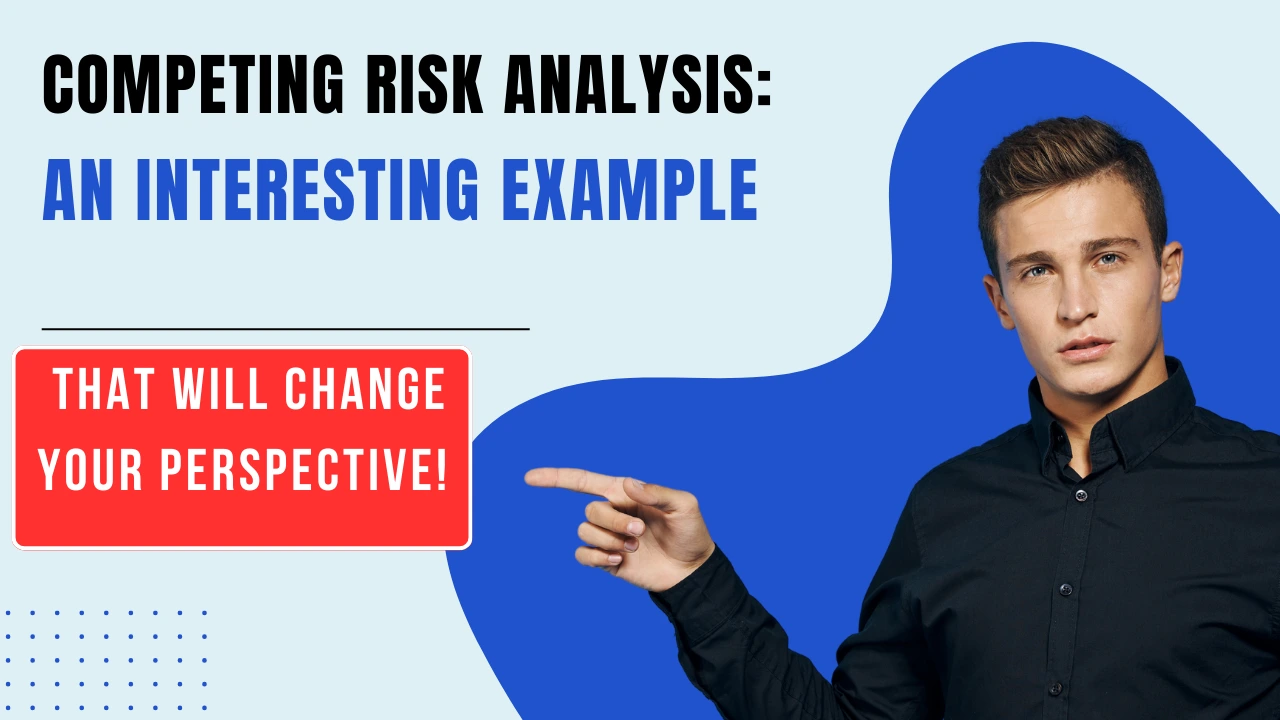Introduction
Competing risk analysis is a crucial tool used in various fields to understand the complex nature of events that can occur simultaneously and compete with each other. By delving into this topic, we can gain valuable insights into the importance of accounting for competing risks and how it affects decision-making in different domains. In this article, we will explore the fundamentals of competing risk analysis, its real-life applications, and even delve into an eye-opening example in cancer research. Brace yourself for a paradigm shift in your understanding of competing risks!
What is Competing Risk Analysis?
Competing risk analysis tackles scenarios where multiple types of events can occur, each with its own probability of happening. These events, known as competing risks, can hinder or modify the occurrence of each other. For example, in medical research, a patient may face the risk of multiple diseases or outcomes simultaneously, making it crucial to understand the interplay between them.
When it comes to competing risk analysis, there are two main types of competing risks encountered:
- Disease-related competing risks:
- These are risks associated with different diseases or health conditions that a person may face simultaneously. For instance, a patient may have the risk of developing heart disease, diabetes, or cancer concurrently.
- Treatment-related competing risks:
- These risks emerge when different treatment options are available for a specific disease or condition. The choice of treatment might influence the occurrence of other events, such as adverse reactions or complications.
It is important to note that there are other relevant factors that can also come into play in competing risk analysis. These factors may include demographic characteristics, lifestyle choices, genetic predispositions, or environmental influences.
The Fundamentals of Competing Risk Analysis
At the core of competing risk analysis lies the concept of the cumulative incidence function (CIF). The CIF represents the likelihood of experiencing a particular event, considering the occurrence of competing events as well. It provides valuable insights into the individual probabilities of each event happening over a specific time period.
Contrasting the CIF is the hazard function, which indicates the rate at which events occur during a given time interval. While the hazard function focuses on individual events, the CIF takes into account the impact of competing risks.
To perform competing risk analysis effectively, the Fine-Gray proportional subdistribution hazards model is commonly employed. This statistical model allows us to evaluate the impact of covariates on the likelihood of experiencing different events simultaneously, considering the presence of competing risks.
Interpreting the results of competing risk analysis involves analyzing the subdistribution hazard ratios for each event. These hazard ratios help us understand the relative impact of different factors on the occurrence of competing events, giving us a comprehensive understanding of the risks involved.
Real-life Applications of Competing Risk Analysis
Competing risk analysis finds extensive application in medical research and clinical trials. By evaluating the occurrence of various outcomes simultaneously, researchers can gain a holistic understanding of patients’ conditions and assess the effectiveness of different treatments. This approach allows for more informed medical decision-making and provides a clearer picture of the overall risks and benefits associated with each option.
Outside of healthcare, competing risk analysis also plays a crucial role in insurance and actuarial science. By considering various causes of mortality simultaneously, insurers and actuaries can accurately calculate mortality rates and assess the financial risks associated with different factors. This helps in designing insurance policies with appropriate coverage and pricing.
Eye-Opening Example: Competing Risk Analysis in Cancer Research
To illustrate the practicality of competing risk analysis, let’s explore a case study in cancer research. Cancer, being a multifaceted disease, often presents multiple types of cancer as competing risks. The choice of treatment can have a significant impact on the progression and occurrence of these different cancer types.
By applying competing risk analysis techniques, we can calculate the cumulative incidence function (CIF) for each cancer type, considering the presence of competing risks. This allows us to weigh the risks associated with each cancer type and gain insights into their relative probabilities of occurrence.
Furthermore, by employing the Fine-Gray model, we can compare the subdistribution hazard ratios for different treatments and evaluate their impact on the competing risks. This analysis helps clinicians and patients make more informed decisions regarding treatment options and assess the potential trade-offs involved.
Analyzing the example provides us with invaluable insights into the complexity and importance of considering competing risks in cancer research. It underlines the significance of accounting for multiple factors simultaneously to make the best possible decisions.
Potential Challenges in Conducting Competing Risk Analysis
While competing risk analysis offers great potential, it also comes with its fair share of challenges. Data limitations and availability can pose obstacles when trying to gather comprehensive information on different events and factors. Proper selection and handling of covariates can be another challenge, as the choice of these variables can significantly impact the analysis outcomes.
Moreover, dealing with potential bias and confounding factors is crucial to ensure the accuracy and reliability of the results. Careful consideration of these challenges is needed to conduct robust and insightful competing risk analysis.
Advanced Techniques for Competing Risk Analysis
To further enhance the accuracy and depth of competing risk analysis, advanced techniques have been developed. Extended Fine-Gray models allow for more nuanced analysis by incorporating additional covariates and interactions. Accounting for time-dependent covariates ensures that the changing nature of events and risk factors is properly addressed. Additionally, sub-distribution hazard ratio interpretation provides a more nuanced understanding of the impact of different covariates on competing risks.
These advanced techniques expand the horizons of competing risk analysis and allow for a more comprehensive exploration of complex scenarios.
Competing Risk Analysis Software and Tools
Several software options are available to support competing risk analysis. These tools offer various features and capabilities to assist researchers and analysts in conducting comprehensive analyses. Popular software for competing risk analysis includes but is not limited to:
- R: A versatile statistical programming language with several packages dedicated to competing risk analysis.
- Stata: A comprehensive statistical software that provides efficient tools for analyzing competing risks.
- SAS: A widely used statistical software with modules specifically designed for competing risk analysis.
It is essential to compare the features and capabilities of available tools to select the most suitable option for specific research needs.
Critiques and Controversies Surrounding Competing Risk Analysis
Like any statistical method, competing risk analysis is not immune to criticisms and ongoing debates within the field. Some researchers have raised concerns about the assumptions and limitations of the Fine-Gray model, proposing alternative models to address potential issues. As the field evolves, these debates contribute to the continuous improvement of competing risk analysis methods.
Understanding and acknowledging the limitations of competing risk analysis is crucial for further research and development in this area. Future research should address these limitations to ensure even more accurate and applicable results.
Summary: The Takeaways from Competing Risk Analysis
Competing risk analysis is a powerful tool with broad applications in various fields, such as healthcare, insurance, and actuarial science. Understanding and accounting for multiple competing risks enable researchers, clinicians, and decision-makers to make informed choices and assess the potential consequences of their actions more comprehensively.
Through the exploration of competing-risk analysis fundamentals, real-life applications, a captivating example in cancer research, and advanced techniques, we have gained valuable insights into the intricacies of this method. By embracing competing-risk analysis, we can unlock a deeper understanding of complex scenarios and improve decision-making processes.
Frequently Asked Questions (FAQs)
- What are the main challenges in conducting competing-risk analysis?
- Data limitations and availability, proper selection and handling of covariates, and dealing with potential bias and confounding factors are some of the main challenges in conducting competing-risk analysis.
- How can competing risk analysis impact medical decision-making?
- Competing-risk analysis provides a comprehensive understanding of multiple events occurring simultaneously. This enables medical professionals to make more informed decisions regarding treatment options and assess the potential risks and benefits associated with each choice.
- Is there a universally agreed-upon model for competing risk analysis?
- The Fine-Gray model is widely used in competing-risk analysis, but it is not universally agreed upon. Alternative models have been proposed to address limitations and improve accuracy.
- What are the major limitations of competing-risk analysis?
- Some limitations of competing-risk analysis include data constraints, potential bias, and confounding factors. Additionally, the assumptions and limitations of certain models, such as the Fine-Gray model, have also been subjects of debate.
With these FAQs, we aim to address some common queries and foster a deeper understanding of competing-risk analysis.



